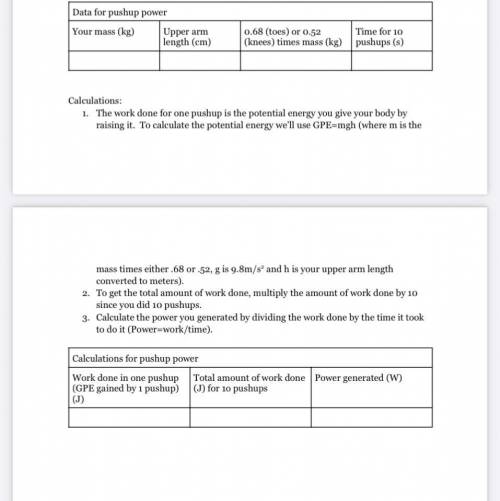Background information:
We know that power is the rate that work is done; what that
really me...

Physics, 30.03.2021 19:00 KKHeffner02
Background information:
We know that power is the rate that work is done; what that
really means is that power tells up how much work is done every
second. To calculate power we just divide the amount of work that
was done by the time it took to do it (Power=work/time). Work is
measured in Joules and time is measured in seconds, we end up with Joules/sec when we calculate power. A Joule/sec is a Watt; we’ll use Watts to measure and compare power.
We also know that the work done on an object is the amount of energy it has gained. For this activity, you’ll be raising your body up as you do pushups which means you’ll be giving your body gravitational potential energy (GPE). To calculate the amount of GPE we multiply mass time gravity times the height raised (GPE=mgh).
What to do (record everything in the table):
1. You need to have a decent estimate of your mass in kilograms: On earth, every
kilogram weighs 2.2 pounds. Either measure your weight on a scale or just
estimate it (in pounds) then divide by 2.2 to get your mass in kilograms.
2. Measure or estimate the length of your upper arm from your elbow to your
shoulder in centimeters...this is how high you raise yourself for every pushup.
3. Decide if you’ll do regular pushups (on your toes) or simpler pushups (knees). If
you are doing regular pushups, multiply your mass by 0.68 because you’ll only be lifting about 68% of your mass each time; if you’re doing simpler pushups, multiply your mass by 0.52 because you’ll only be lifting about 52% of your mass each time.
4. Measure the time it takes for you to do 10 pushups.


Answers: 3
Another question on Physics

Physics, 21.06.2019 23:40
Aregular polygon has angkes of size 150° each.how many side has the polygon
Answers: 1

Physics, 22.06.2019 03:50
A30 kg weight lies on top of a massless piston of area a = 0.01 m2 the exterior air is at a (constant) p =1 atm and t = 27 c. the interior gas is 0.4 moles of (ideal) n2 and it has initial temperature 27.00 degrees c. 1. what is the initial pressure in the interior? a. 29.4 kpa b. 130.7 kpa c. 101.3 kpa the next three questions concern what happens when an amount of heat q is slowly added to the interior, raising the piston by 1 mm and raising the interior temperature to 27.40 c
Answers: 3

Physics, 22.06.2019 09:00
The material that keeps its new shape after it is stretched is called?
Answers: 1

Physics, 22.06.2019 09:00
When a bicycle coasts uphill, it moves slower and slower as it climbs. why? a. its kinetic energy is transforming into heat energy. b. its potential energy is transforming into kinetic energy. c. its kinetic energy is transforming into potential energy and heat energy. d. its potential energy is transforming into kinetic energy and heat energy.
Answers: 1
You know the right answer?
Questions

Advanced Placement (AP), 23.07.2021 19:10




Physics, 23.07.2021 19:10

English, 23.07.2021 19:10


Mathematics, 23.07.2021 19:10



Advanced Placement (AP), 23.07.2021 19:10



History, 23.07.2021 19:10

Mathematics, 23.07.2021 19:10


Mathematics, 23.07.2021 19:10

Business, 23.07.2021 19:10

English, 23.07.2021 19:10

Mathematics, 23.07.2021 19:10



